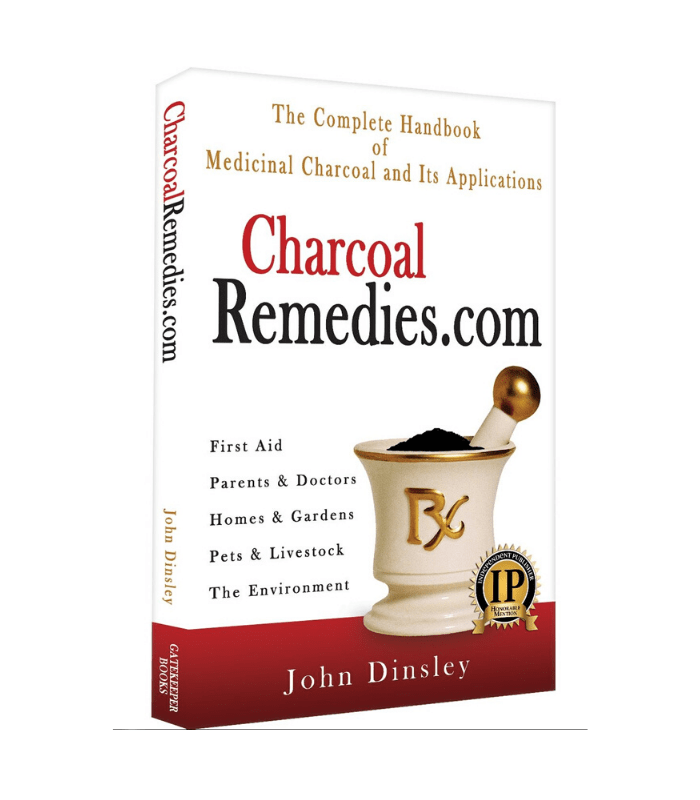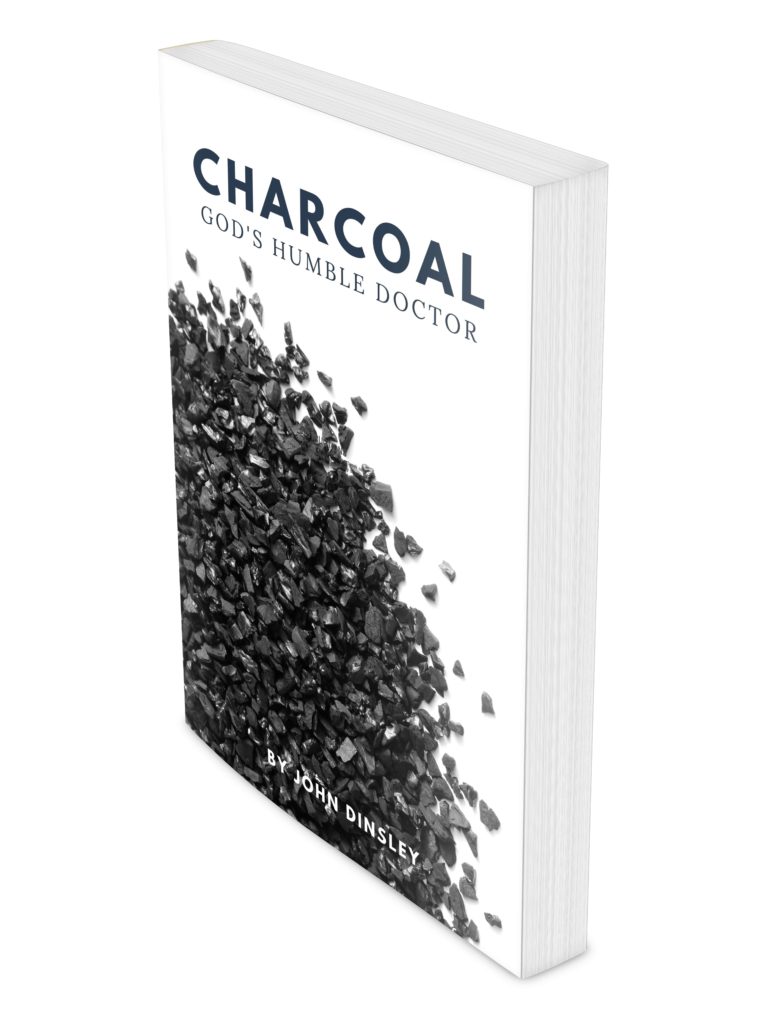Uganda 2012
For those who are not aware of our travels and Public Health Programs, in 2011 Kimberly and I traveled to Uganda to conduct a number of health emphasis/natural remedy workshops. (Read Uganda 2011) The four weeks took us from central to western Uganda and back to Kampala. Clearly the people saw the benefits of this natural disease prevention approach and were captivated with our talks on medicinal charcoal, simple hydrotherapy treatments and some common herbs. Since our return we have received some remarkable stories. We also received an invitation to come back.
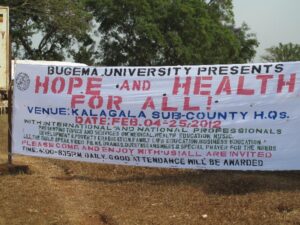
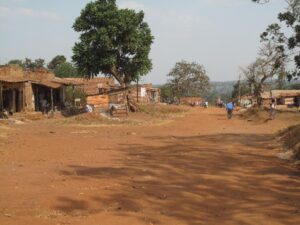
Kalagala
At the invitation of Doctor Gebre Worancha of Bugema University, I traveled back to Uganda in February of this year to teach about natural medicine as part of an evangelistic effort by the University in the village of Kalagala. The 3-week program was entitled “Hope and Health for All.” This certainly was a new experience for me to talk on both the practical applications of physical and mental health, as well as the spiritual side. To announce the beginning of the programs, Bugema University organized a drum and brass band to march through the village, inviting all to the first day’s events. The children were delighted and the adults… amused, skeptical, leery…

The village of Kalagala has a population of about a thousand. Soon people began to come. District dignitaries, village chief and elders, children, young people, adults, and the seniors. It was a typical poor farming community. It was only 12 miles away from the University, but it could take us 45 minutes to drive. Thankfully it did not rain until my last day. Each afternoon, from 4:30 to 6:30, I conducted health classes. A large tent was purchased that had sides. This helped to minimize children traffic and countless other distractions. The children had programs for them under a large tree so their parents could better concentrate. The enclosed tent also allowed me to project a Powerpoint program. It does not seem to matter whether people are poor and illiterate, or prosperous and educated, whether from a developed or developing country, everyone quickly becomes focused on the simple illustrations. Unfortunately the tent very soon became too small.
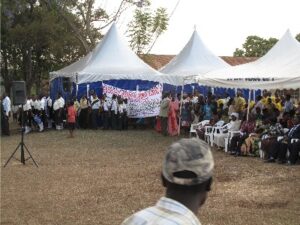
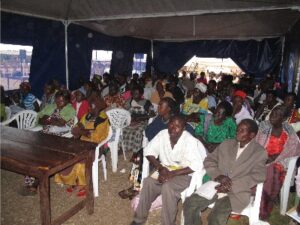
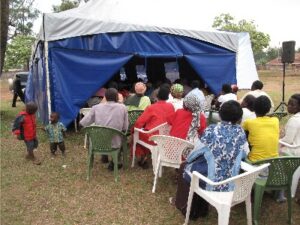
The slides of the body’s invisible anatomy captivated the audience and it was an easy matter to bridge the functions of each organ and what we can all do to make the whole body work the most efficiently and healthfully as possible.
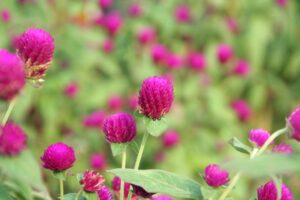
We also looked at a number of natural plant remedies, some from America, some native to Africa, and Uganda in particular. I was amazed to see some people knew nothing about the powerful medicinal properties of Aloe Vera, which is so common there. But then I am also so amazed to see Americans so oblivious to the medicinal applications of red clover. It seems people everywhere have been seduced into abandoning God’s simple natural medicinal plants for the much more dramatic poisons of witchcraft or modern medicine.
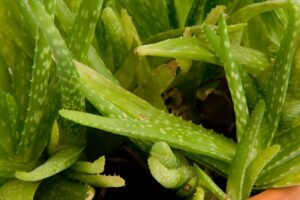
Along with plant medicines, we also covered the principles underlying hydrotherapy, and demonstrated several different treatments that were doable considering the circumstances—cooking over open fires, run-and-fetch-it running water, scarcity of cloth and towels. The village chief was not all that keen on this troop of people invading her small village. But after several days of listening from afar (megaphones were set up so as to blast most of the village so they could hear even if they didn’t come), she came and took me aside and asked what she could do for her little child who had chronic sinus congestion. I described a couple simple hydrotherapy treatments she could use, including a hot footbath and moist hot packs over the face. Two days later she came and wanted to give me her report. It only took 15 minutes of the hot moist packs over her sinuses and they opened up and drained and was completely over whatever had sparked the problem. Needless to say she was one very pleased mother. So much so, that at the end of our 3 weeks she came and publicly asked if the team could stay one more week. God is good!
Of course I also talked at length about charcoal. There had been considerable hoopla before hand about this musungu (white man) coming to talk about the medicinal use of charcoal. The people had good reasons to be more than skeptical. Imagine someone trying to sell you the idea that something so common as charcoal, that is little better than the dirt under your feet, something the children, dogs and goats pee on, is so powerful a medicine that it is used in every modern hospital in the world. That is called a hard sell.
Nevertheless, after lots of laughing and rolling of eyes, it didn’t take long looking at the Powerpoint program to settle everyone down, and for serious expressions to take the place of humor. Was it possible that God had given these people something so present in their lives that could deal with some of the real big hitting causes of sickness and death? It wasn’t long before we were hearing first hand how charcoal was working in Kalagala.
Malaria Fever
One bright young mother never failed to be there on one of the front rows with her infant. But it was obvious to me, that as robust as the baby looked, it was sick. Sometime that first week she came and asked what could I recommend for her baby. I reached over and felt his forehead—very bad fever! I felt the belly and it too felt very hot. According to the mother a doctor had diagnosed malaria, which was certainly a good possibility. But malaria is often the easy diagnosis and quinine the easy treatment. Maybe it was the expression on my face, but I said something to the effect that, “Quinine is pure poison and it shouldn’t be given to an adult let alone a small child!” Anxiety and fear flushed over that young mother’s face and I feared I had said too much. I went on to tell her several things she should try—I don’t recall mentioning charcoal.
The next day I was seated outside the tent, before the afternoon program began, answering questions from different people, when this young mother walked up with her baby and sat down next to us. Instantly I saw the baby was not sick. I reached over and felt his head and belly—NO FEVER! The mother just gave this big smile and turned to the other women in the group and started chatting in Luganda. Soon the other women began clapping and saying “Amina, amina!” (Amen, Amen!) I asked the translator what she was saying. After my less than careful comment the previous day, the young mother went home, and followed my instructions from a previous talk for making a charcoal drink for babies: first selecting some charcoal; washing it with boiled water; grinding and sifting it; then making a charcoal slurry with boiled water; letting the charcoal settle out; then pouring the “gray” water into a baby bottle, and giving that to the sick child. How long did it take to have an effect? “In about 15 minutes the fever began to leave, and it is now completely well!” To God be the praise!
Do you think that young mother was happy? Do you think she told others? Do you think she was ready to listen to what we might have to say about spiritual health?
Wasp stings, digestive problems, painful joints, infections, these were some of the stories people began to share amongst themselves as they came to learn more about how God wants us to be well, and how to get back our health if we get sick—without having to experiment with some witch doctor’s poisonous concoction.
The Cow Girl
Oh yes, the little girl who was tending the cow that took off and somehow the rope got caught around her neck and miraculously her life was spared—only for a bad infection to settle into the burn wound. But one of the translators brought the girl to us after dark and asked if we could give her a charcoal poultice. We took some pictures then wrapped the neck with the poultice, and again had prayer.
Next Day: I am always amazed at what charcoal can do, but there are times I know it wasn’t the charcoal. Bad wounds like that just don’t disinfect overnight. I was speechless. People gawked. At that point some of the young people took over making charcoal poultices and by the end of the ten days the scabbing was almost all gone.
Leg Wound

Back at Bugema University my morning time was used giving talks specifically on the use of charcoal. The word quickly spread and one Thursday afternoon I was paid a visit by a student limping up to my cottage with one crutch. It seems he had had a bad bodaboda (motorcycle) accident that had left him a severely punctured and infected leg. It had in time healed over, only to have the infection resurface a short distance away. Antibiotics proved ineffective. The wound was getting deeper, and enlarging, and the pain was increasing. “Mr John, do you think charcoal would help?” he asked hopefully. It was little trouble to quickly make a charcoal poultice and apply it over the wound. We had a short prayer together, and sent him on his way with material to make another one. Sunday morning, three days later, there is a knocking at my door and there stands the young man without his crutch and smiling broadly. “Pain is gone!” I unwrapped the bandage and it was remarkable to see not only that the infection was gone, but new tissue was already forming around the open wound and in the wound. Amazing—the chemistries of charcoal and prayer working together!

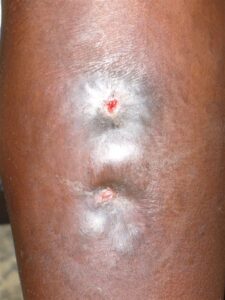
Equally amazing is how fast a story like this can sweep across a campus of 4,000 students—without Facebook! Part of the excitement is to discover they have a “tool,” something they can take back to their villages or wherever they go.
Making Charcoal Powder
Okay, time to teach someone how to make their own charcoal and demonstrate it at the Kalagala program. Hope, from Ghana, was more than willing, as Community Development was her main study. I purchased a 50 lb sack of charcoal—it was a mixture of different hardwoods including Eucalyptus and Guava. Hope selected the hardest pieces, washed away the most obvious dirt, then washed again with boiling water to sterilize them. After being allowed to dry sufficiently in the sun, she then set to pounding it in a traditional hollowed out log with a five foot pole rounded on one end. After pounding, the mixture was first sifted through a coarse mesh flour sifter, and then a very fine mesh flour sifter. The large pieces were all returned to the urn to be pounded again, and the process repeated over and over. Four hours of this tedious and hard work produced five gallons of fine sifted charcoal powder. At this point it would suit me better to see the powder laid on metal trays and heated again to sterilize the powder, allowed to thoroughly dry, and then stored in sterilized glass jars. Sanitation can never be over emphasized, whether in a primitive village or a modern cosmopolitan city.
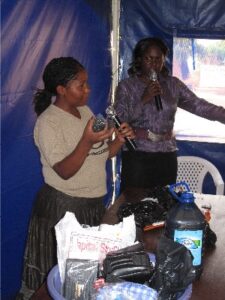
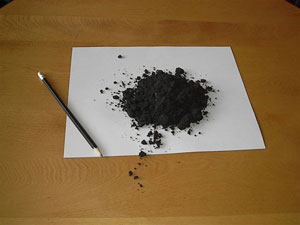
With another young woman translating, Hope explained the whole process at our afternoon meeting, and then gave out free samples. The people were so excited to learn AND to get these samples. We then invited different ones up to be “patients” and some to be “nurses” to practice making and applying charcoal poultices. One of the first volunteer “nurses” was the mother of the baby that had been afflicted with the malaria fever. We ran out of light and time long before we ran out of volunteers. It was a very moving experience!
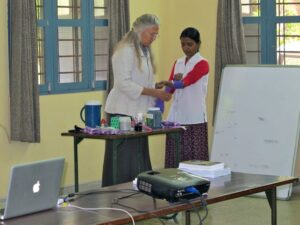
Malaria – HIV/AIDS – Infant Mortality – Infertility
Willy is the director of a humble NGO (Non-Governmental Organization) that is involved in Rural Health Care projects, such as water wells, and also operates an Orphanage for HIV/AIDS children. Uganda has the highest incidence of HIV/AIDS in the world. It was his search for alternative solutions to HIV treatment that brought Willy to our Website in 2010. “Would charcoal help?” he asked. “It should help with the diarrhea, nausea and vomiting that often attend these pitiful sufferers,” I replied. If the charcoal can relieve some of the load on the liver and kidneys, that should translate into a measure of relief. Willy reported back a couple months later that indeed the patients were experiencing more energy through the day but would have to take more charcoal the next day. Willy invited us to join him when we came to Uganda in 2011. But Willy had other personal health concerns.
Infant mortality is so high in Uganda, as it is in many developing countries, that often the baby is not given a name until several months pass. As numbing as infant mortality is, carrying a baby to term or even getting pregnant is no less a great worry for these people who depend so much on children as their support in old age.
Charcoal Babies
I invited Willy to come from Kampala to share some of his experiences with the village folk. Gladys and her cousin also came. Gladys, Willy’s wife, was not able to carry her baby to term. What should they do?
“Greetings from RHCF Uganda. Before we started using charcoal, Gladys conceived and after five month we got a miscarriage. We didn’t know what was the problem and after a serious test in her womb doctors found that she had fibroids, and we were told that the only way of treating it is through going under surgical operation. We decided to use herbs, and we chose charcoal as a remedy for our problem. After a few months, again she was pregnant, and each week she was drinking a glass of charcoal [water] and she felt good—no fever. She had enough energy and she didn’t take any prescribed drug from [the] clinics for a period of nine months. Then she gave birth to a baby boy and now the boy looks good and is strong. Charcoal is a remedy to many human difficulties.”
As you can see from the picture, Ryan is definitely a healthy looking baby and he is the right color for a “charcoal baby”!

Standing next to Gladys is her cousin, who was not even able to get pregnant (apparently an increasing problem—what could the cause be?). After their success, Gladys suggested charcoal for her cousin. It is not so obvious, but in the picture she is 3 months pregnant.
Now when Gladys gave her testimony there was an eruption of clapping, and a chorus of Aminas (Amens), especially among the women. Considering the high mortality during birth and infancy, and the huge emphasis on having children, it is not difficult to appreciate the corporate joy for this young woman. When Gladys’ cousin gave her short testimony the tent broke out in hooting, Aminas, clapping, and shouting there was so much joy for this young woman who was a complete stranger to the village.
For the record, I did not suggest charcoal for their problem. It was something they decided to try after their own experimenting with charcoal for other issues.
Other Issues.
“In fact I receive a lot of short stories about charcoal, but I don’t have pictures of the people telling. One thing about charcoal it cures a lot of different diseases. Like for me, three weeks [ago] I caught malaria while I was on the way coming from Mubende town. By the time I reached home it [the fever] was high. I took 2 spoons of charcoal powder in a full cup of water. The next day I was ok without any feeling of fever. And another story of people affected with HIV, charcoal helps them to gain strength faster, I had a lot of stories about it.” (Remember Willy is the director of an orphanage for HIV/AIDS children.)
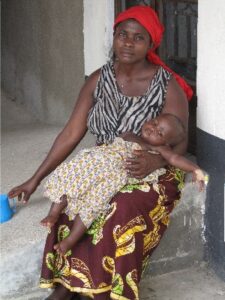
When All Is Said and Done—it POURS!
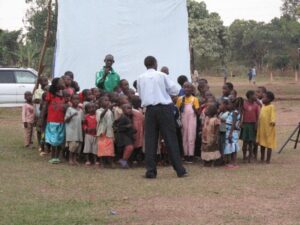
I don’t have space to relate all the amazing stories, “coincidences,” frustrations, breakdowns, delays, answers to prayer. I have not mentioned all the other classes that ran simultaneously in the afternoon provided by Bugema University—family planning; agriculture; free doctor clinics; finance; HIV/AIDS prevention; musical programs; children’s programs; and more. I don’t have pictures of the mountain of cloths that was gathered by the Bugema campus and distributed, or the bags and bags of peanuts Pastor Gebre and Tadu, his wife, prepared and handed out to scores of amazed children—children who were gathered together to hear stories and play simple games and sing to the hundreds of people who gathered for the evening program and videos on the giant screen. And then it was all but over.
As Pastor Gebre was finishing up his closing remarks, clouds rolled up, the lightening and thunder rolled over the hills, and some drops began to fall. As he closed the program with prayer, it seemed the “windows of heaven” once again opened. The dry season, which normally began four weeks earlier, was officially over. Everyone was happy! Within fifteen minutes the road home was turning into a small river. Truly “Showers of Blessing.”
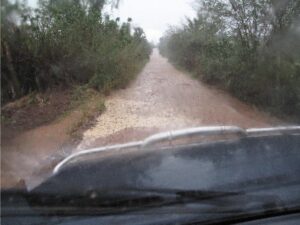
It is not over until it is over.
Prior to the outpouring of rain, some ninety individuals (teenagers, young adults, seniors, and one parapalegic woman) chose to commemorate and celebrate their new lease on life by being baptized—a laying down of the old and rising up with the new. Even as the rain intensified, the people loaded onto a large bus sent by Bugema University to plow its way back down the road to the highway and bring them to the campus. That in itself was a first for most. Just as suddenly as it began to pour, so it stopped. Each person was given a robe and then invited into the small baptistry. There is the teenage girl that helped with translating. There is the woman army officer. There is the former soldier (and former town drunk). There is the young mother.
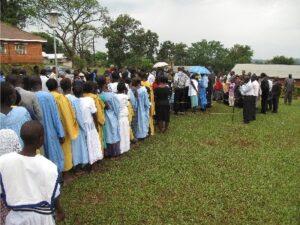
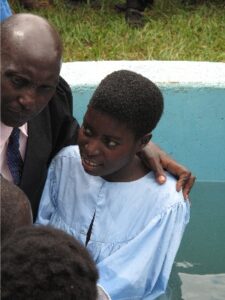
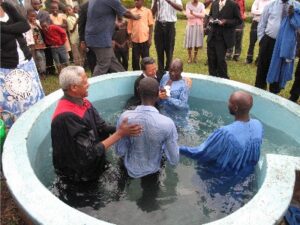
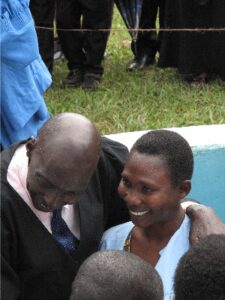

And there was more. Bugema University Cafeteria Cooks then prepared and served all a traditional meal with a few treats few would ever have. And the bus loaded up its precious cargo and carried them all home.
Thank You ALL!
I must give a big thank you to Bugema University. For Doctor Gebre’s invitation, watch care and guidance, for his wife Tadu and her delicious meals. For Vice Chancellor Patrick Manu and his solid support for the programs in every way, and his wife Grace’s enthusiastic hospitality. For the young men who so eagerly translated our many talks non-stop for hours. For the young women who prepared charcoal and assisted in demonstrations. The staff and students who set up tents, PA system, giant screen, made the children feel special, and cleaned up every night for 3 weeks. To all a big thank you for your kind and energetic support. We all share in the reward of seeing the village of Kalagala equipped with practical knowledge that can insure both “Hope and Health for All.” Of course, a big thanks to the village elders and the townsfolk for allowing us to come and for your gracious invitation to come again.
Thank you Kimberly for managing home and business so well while I was gone, but I much prefer to have you with me on these priceless adventures. Next time…
Then, without God, all this would only have been some wishful thinking on my part back in frigid Nebraska. Thank YOU!
Public Presentations
Uganda is the result of one invitation to speak in one country that led to an invitation in another country that led to an invitation to western Uganda in 2011. If you are interested in having John & Kimberly Dinsley come to your country please contact them at editor@buyactivatedcharcoal.com Who knows…
Table of Contents

John Dinsley
Born in British Columbia, Canada, John Dinsley has lived, and worked from South America to the North Pole, from Nova Scotia to Nepal. He is trained as a lifestyle counselor, teaches public health programs, home remedies workshops, and has operated a family care home. He and his wife Kimberly are the owners of Charcoal House LLC. They often travel together across the U.S. and internationally to conduct charcoal workshops. He is a carpenter by trade, has managed an organic market garden business, and volunteered in overseas development work. When he is not building, teaching or gardening, he enjoys writing.

